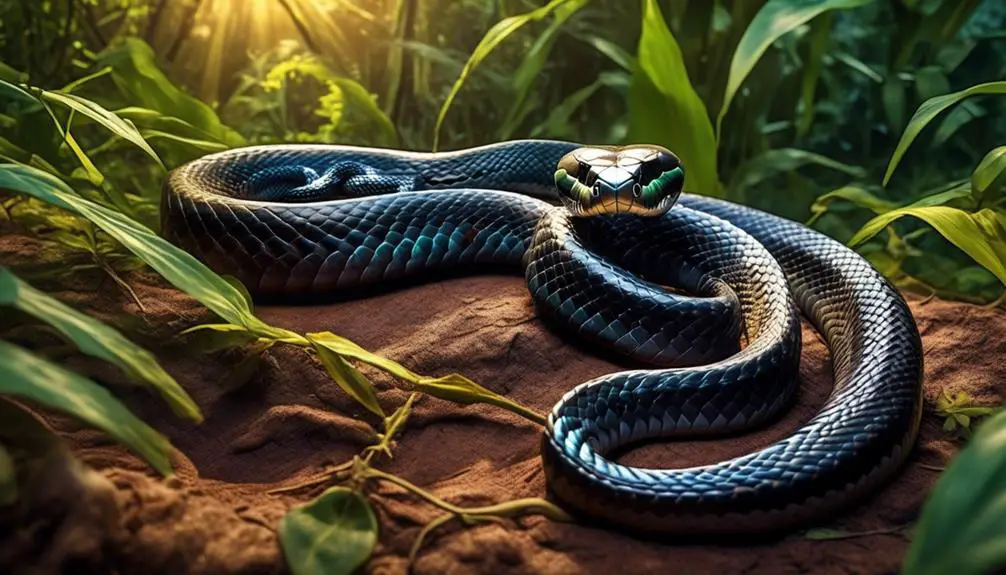Are you ready to embark on a thrilling adventure through the vast and diverse landscapes of Africa?
Before you set foot on this captivating continent, it is crucial that you arm yourself with knowledge about the venomous snakes that call Africa home.
In this article, we will uncover the mysteries surrounding these dangerous species, revealing their hidden dangers and the risks they pose to unsuspecting travelers.
Brace yourself as we delve into the world of venomous snakes in Africa, where danger lurks in the shadows and survival depends on your ability to avoid these treacherous creatures.
Black Mamba
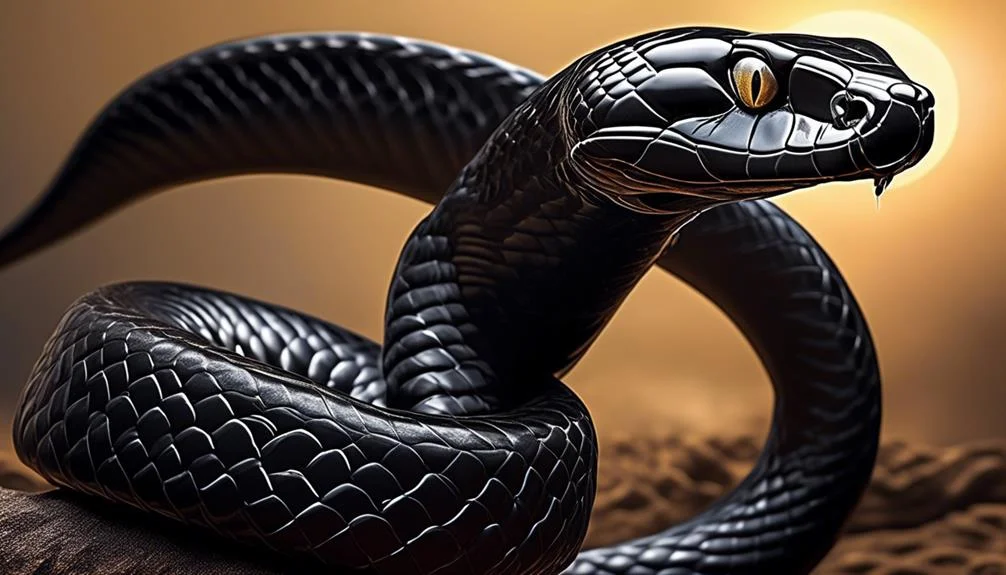
The Black Mamba, a highly venomous snake found in Africa, is known for its olive or greyish brown color. It possesses venom that contains neurotoxins and cardiotoxins, which can take effect within as little as 10 minutes. This deadly venom targets the nervous system and the heart, causing severe damage to its victims.
The Black Mamba can reach lengths of up to 14 feet and is capable of traveling at speeds of up to 12 miles per hour, making it one of the fastest snakes in the world. Its speed and agility, combined with its potent venom, make it a formidable predator.
The Black Mamba’s aggressive nature and potent venom make it one of the most dangerous snakes in Africa. Its bites are often fatal if not treated immediately, making it a snake that should be avoided at all costs.
Puff Adder
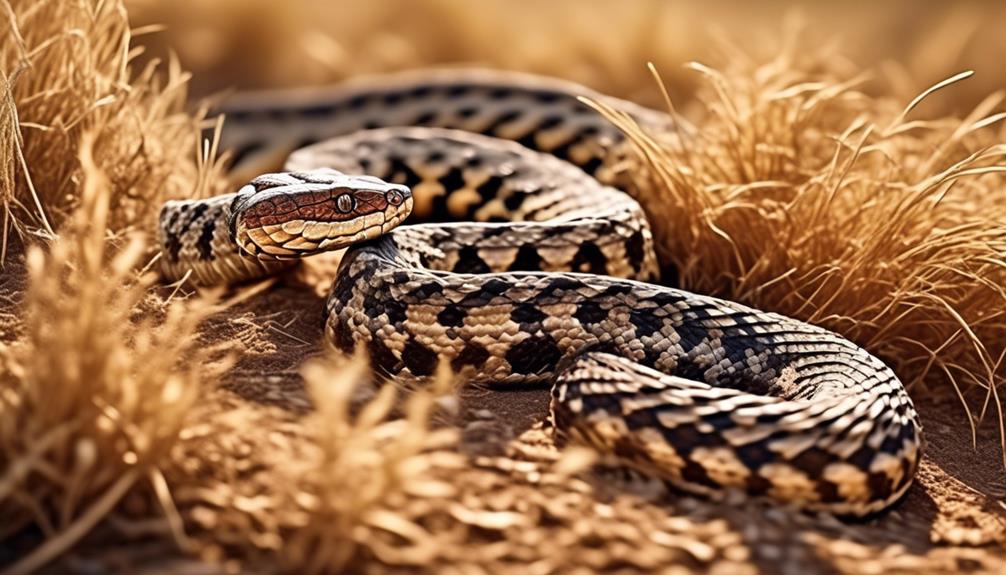
Accidentally stepping on a Puff Adder can lead to a potentially fatal snake bite due to its common presence and widespread distribution throughout Africa. The Puff Adder (Bitis arietans) is responsible for the most human deaths in Africa, making it a snake species to avoid. This venomous snake is known for its camouflage, which allows it to blend in with its surroundings, making it difficult to spot. Here is a table highlighting key characteristics of the Puff Adder:
| Puff Adder | |
|---|---|
| Scientific Name | Bitis arietans |
| Length | Up to 5 feet |
| Weight | Up to 40 pounds |
| Coloration | Varied, with a pattern of dark brown or black patches on a lighter background |
| Venom | Hemotoxic, causing pain, swelling, and tissue damage |
| Distribution | Widespread throughout Africa |
The Puff Adder is known for its ambush hunting strategy, lying in wait for unsuspecting prey to pass by. Unfortunately, this behavior also puts humans at risk of accidental encounters. When disturbed or threatened, the Puff Adder will hiss loudly and strike with lightning speed, injecting its venom into its victim. Immediate medical attention is crucial in the event of a Puff Adder bite, as the venom can cause severe pain, swelling, nausea, and shock. Deaths can occur within 24 hours if left untreated. It is important to exercise caution and be aware of the presence of Puff Adders when venturing into snake habitats in Africa.
Saw-Scaled Viper
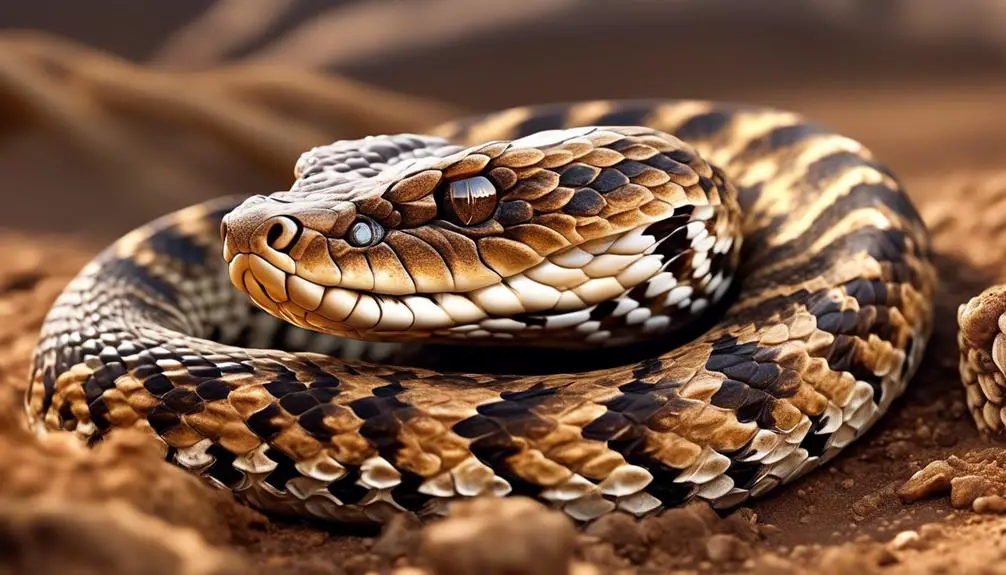
Now let’s turn our attention to the Saw-Scaled Viper, often considered the most dangerous snake in certain regions of Africa. This snake is known for its aggressive striking behavior, often striking multiple times when threatened.
Its venom is haemotoxic, causing hemorrhaging and kidney failure, which can be particularly devastating in remote regions with limited access to medical care.
With its nocturnal habits and rasping warning sound, the Saw-Scaled Viper poses a significant threat to those who encounter it in the wild.
Aggressive Striking Behavior
With its aggressive nature and tendency to strike multiple times, the Saw-Scaled Viper is often recognized as the snake with aggressive striking behavior. This small but highly venomous snake has a reputation for being one of the most dangerous snakes in certain regions.
The Saw-Scaled Viper possesses haemotoxic venom, which can cause hemorrhaging and kidney failure. It’s found in remote regions with limited access to medical care, making its bite even more concerning.
Nocturnal in nature, the Saw-Scaled Viper makes a distinctive rasping noise when threatened, serving as a warning to potential predators. Its aggressive striking behavior, combined with its potent venom, makes encountering the Saw-Scaled Viper a situation best avoided.
Hemorrhaging and Kidney Failure
The Saw-Scaled Viper, known for its aggressive striking behavior and potent venom, poses a significant threat due to its ability to cause hemorrhaging and kidney failure. This venomous snake is found in remote regions of Africa with limited access to medical care, making its bite even more dangerous.
The venom of the Saw-Scaled Viper is haemotoxic, meaning it affects the blood and can lead to internal bleeding and clotting disorders. This can result in severe hemorrhaging throughout the body, including the kidneys. Kidney failure can occur as a result of the damage caused by the venom, leading to a potentially life-threatening condition.
It’s crucial to seek immediate medical attention if bitten by a Saw-Scaled Viper to prevent these serious complications.
Limited Access to Medical Care
Limited access to medical care in remote regions of Africa poses a significant challenge in treating victims of the Saw-Scaled Viper’s potentially life-threatening bite. The Saw-Scaled Viper, known for its aggressive nature and tendency to strike multiple times, is found in remote areas where medical facilities are scarce.
This means that individuals who are unfortunate enough to be bitten by this venomous snake may face delayed or inadequate treatment, increasing the risk of severe complications and death. The table below illustrates the dire situation of limited access to medical care in Africa and the potential consequences for snakebite victims.
| Limited Access to Medical Care in Africa | Consequences for Snakebite Victims |
|---|---|
| Lack of nearby medical facilities | Delayed treatment |
| Insufficient supply of antivenom | Inadequate neutralization of venom |
| Lack of trained medical professionals | Inadequate management of symptoms |
| Difficulty in reaching remote areas | Limited access to emergency care |
These challenges highlight the urgent need for improved healthcare infrastructure in Africa’s remote regions to ensure timely and effective treatment for snakebite victims.
Boomslang
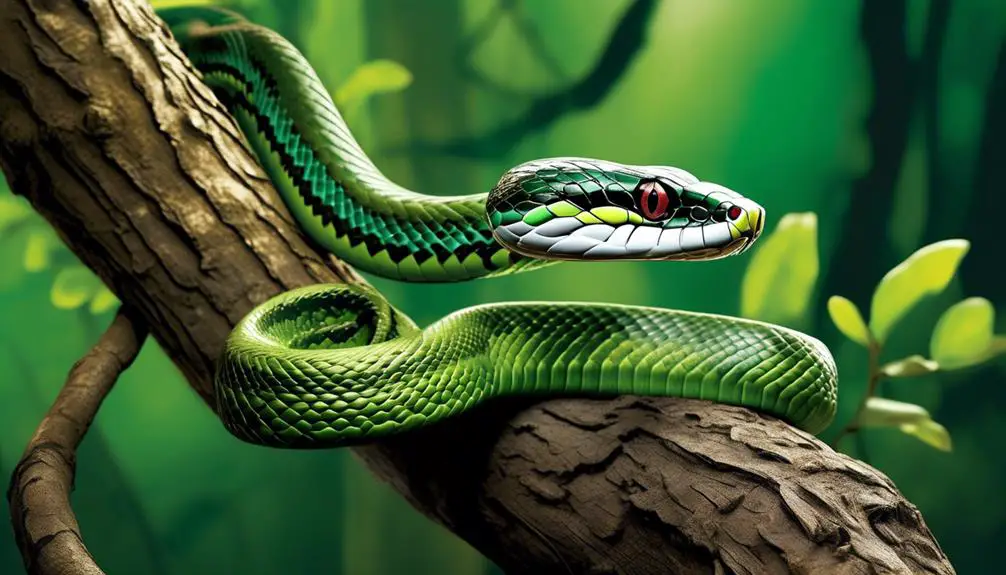
Now let’s turn our attention to the Boomslang, a highly venomous snake that isn’t considered dangerous.
Boomslangs are rarely found on the ground as they’re mostly tree dwellers. They’ve a timid nature and prefer to avoid confrontation, making them less likely to bite.
Incidences of human bites are rare and mostly occur due to intentional handling rather than accidental encounters.
Venomous Tree Dwellers
Nestled among the branches of Africa’s lush forests, the Boomslang snake, with its highly venomous bite, stands as one of the continent’s notable venomous tree dwellers.
This rear-fanged snake, scientifically known as Dispholidus typus, is rarely found on the ground as it prefers a life among the trees. With its slender body and large eyes, the Boomslang is well adapted for its arboreal habitat.
Its venom, though potent, isn’t considered dangerous to humans as it’s primarily used for subduing prey. In fact, incidents of human bites are rare and mostly the result of intentional handling.
Despite its venomous nature, the Boomslang is generally timid and avoids confrontation, making it a fascinating and relatively harmless resident of Africa’s forests.
Rare and Timid
The Boomslang snake, known for its highly venomous bite, is a rare and timid resident of Africa’s forests, preferring a life among the trees. This rear-fanged snake is not considered dangerous as it rarely bites humans and usually avoids confrontation. Incidences of human bites are rare and mostly intentional handling. To further understand the characteristics of the Boomslang, refer to the table below:
| Characteristics | Description |
|---|---|
| Color | Males are bright green, while females and juveniles are brown or olive-green. |
| Size | Adults can grow up to 6 feet long. |
| Habitat | Found in the sub-Saharan forests and woodlands of Africa. |
| Diet | Primarily feeds on birds, eggs, and small mammals. |
| Venom | The Boomslang’s venom is highly potent, causing internal bleeding and other systemic effects. |
| Reproduction | They are oviparous, laying 10-30 eggs in tree hollows or crevices. |
| Conservation Status | Boomslangs are not currently listed as endangered, but habitat loss poses a threat. |
Despite its venomous nature, the Boomslang’s rarity and shy disposition make it an unlikely encounter for most individuals. However, caution and respect should always be exercised when encountering any snake in the wild.
Incidences and Handling
Incidences involving the Boomslang snake are rare due to its timid nature and preference for a life among the trees in Africa’s sub-Saharan forests and woodlands. This highly venomous snake, scientifically known as Dispholidus typus, is rarely found on the ground as it’s primarily a tree dweller.
The Boomslang’s timid disposition and avoidance of confrontation make it less likely to bite humans. Additionally, its venom is delivered through rear fangs, reducing the chance of a venomous bite. However, when human bites do occur, they’re typically a result of intentional handling.
It’s important to exercise caution and avoid handling these snakes, as their venom can cause severe symptoms, including bleeding disorders and organ failure. If bitten, seek immediate medical attention for proper treatment.
Mozambique Spitting Cobra
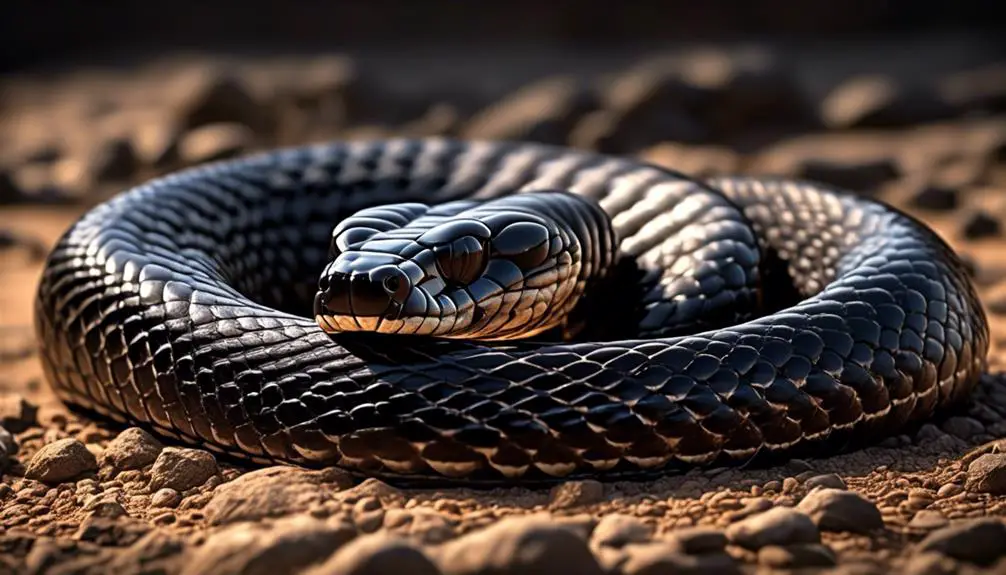
The Mozambique Spitting Cobra, with its ability to accurately spit venom up to 3m, poses a unique threat to those who encounter it. This highly venomous snake, also known as Naja mossambica, is found in various habitats across southern Africa, including grasslands, forests, and wetlands. Its average length is about 1m, and it is characterized by its dark color along the back and paler underside.
One of the most distinctive features of the Mozambique Spitting Cobra is its ability to spit venom with remarkable accuracy. To illustrate this, the following table provides more details about this dangerous snake:
| Mozambique Spitting Cobra | |
|---|---|
| Scientific Name | Naja mossambica |
| Venomous | Yes |
| Average Length | About 1m |
| Venom Delivery | Spit up to 3m |
When threatened, the Mozambique Spitting Cobra will rear back and aim for the eyes of its target. If the venom enters the eyes, it can cause severe impairment or even blindness. The venom itself contains a mixture of cytotoxins and neurotoxins, which can lead to tissue damage, paralysis, and respiratory failure. It is important to exercise caution and avoid provoking this snake, as it is known to be unpredictable and not afraid of confrontation.
Gaboon Viper
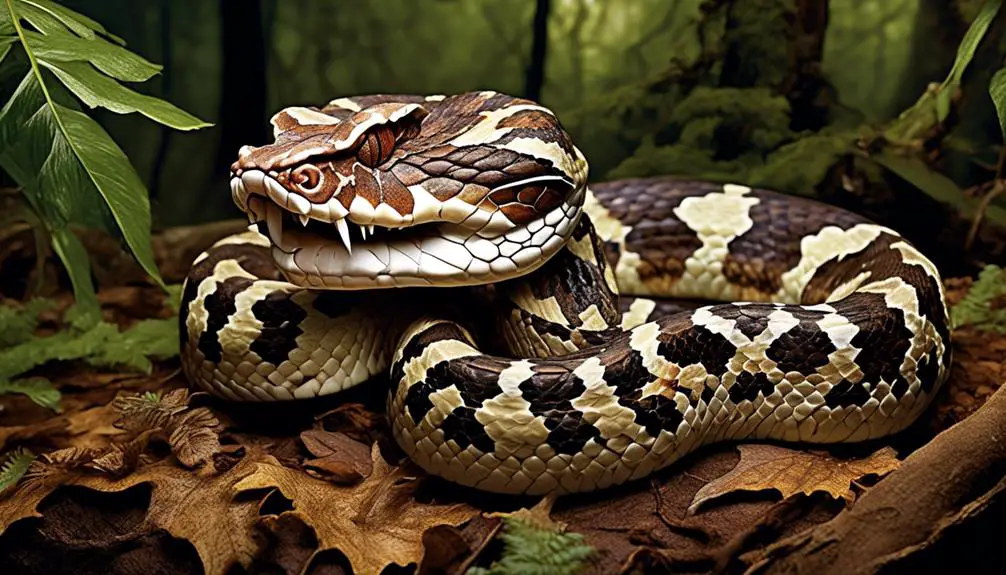
Now let’s turn our attention to the Gaboon Viper, a snake with deadly fangs and a venomous bite.
This species is known for its unique markings and appearance, with rectangular and hourglass-shaped patterns on its body.
Its bite can cause intense pain, respiratory problems, swelling, and blistering.
Despite its generally docile nature, the Gaboon Viper won’t hesitate to bite when stepped on or threatened.
Deadly Fangs and Venomous Bite
The Gaboon Viper possesses the longest fangs, produces the most venom, and inflicts the most excruciating bite among venomous snakes in Africa. This deadly combination makes it one of the most dangerous snakes on the continent. The Gaboon Viper’s fangs can reach up to 2 inches in length, allowing it to deliver a deep and penetrating bite. Its venom glands are the largest among African snakes, producing a potent cocktail of toxins that can cause severe tissue damage, intense pain, and respiratory problems. To give you a better understanding of the Gaboon Viper’s deadly capabilities, here is a table comparing its fangs, venom production, and bite intensity to other venomous snakes in Africa:
| Snake | Fang Length | Venom Production | Bite Intensity |
|---|---|---|---|
| Gaboon Viper | 2 inches | Highest | Most painful |
| Black Mamba | 0.5 inches | High | Very painful |
| Puff Adder | 0.5 inches | Moderate | Painful |
| Saw-Scaled Viper | 0.25 inches | Moderate | Painful |
| Mozambique Cobra | 0.5 inches | Low | Mildly painful |
As you can see, the Gaboon Viper stands out as the snake with the longest fangs, highest venom production, and most excruciating bite. It is crucial to exercise caution and avoid encounters with this formidable serpent.
Unique Markings and Appearance
With its distinctive markings and unique appearance, the Gaboon Viper is easily distinguishable from other snakes in Africa. This venomous species showcases a pattern of rectangular and hourglass-shaped markings on its body, which provide excellent camouflage in its natural habitat. The Gaboon Viper can grow to lengths between 1 and 1.5 meters, making it a relatively large snake.
What sets this viper apart from others is its impressive fangs, which are the longest of any snake species. Additionally, it produces a significant amount of venom and possesses the most painful bite amongst African snakes. When bitten by a Gaboon Viper, victims may experience swelling, blistering, intense pain, and respiratory problems.
While generally docile, this snake won’t hesitate to bite when stepped on or threatened.
Intense Pain and Respiratory Problems
As we shift our focus to the topic of intense pain and respiratory problems, let’s now explore the effects of a bite from the Gaboon Viper, a venomous snake distinguished by its unique markings and appearance in Africa.
The Gaboon Viper, with its rectangular and hourglass-shaped markings, can grow between 1 and 1.5 meters long. It possesses the longest fangs among snakes, produces the most venom, and has the most painful bite.
A bite from this viper causes swelling, blistering, intense pain, and respiratory problems. Although generally docile, the Gaboon Viper will bite when stepped on or threatened. Its venom is a potent cocktail of toxins that can lead to severe complications, making it a snake to avoid encountering in Africa.
Egyptian Cobra
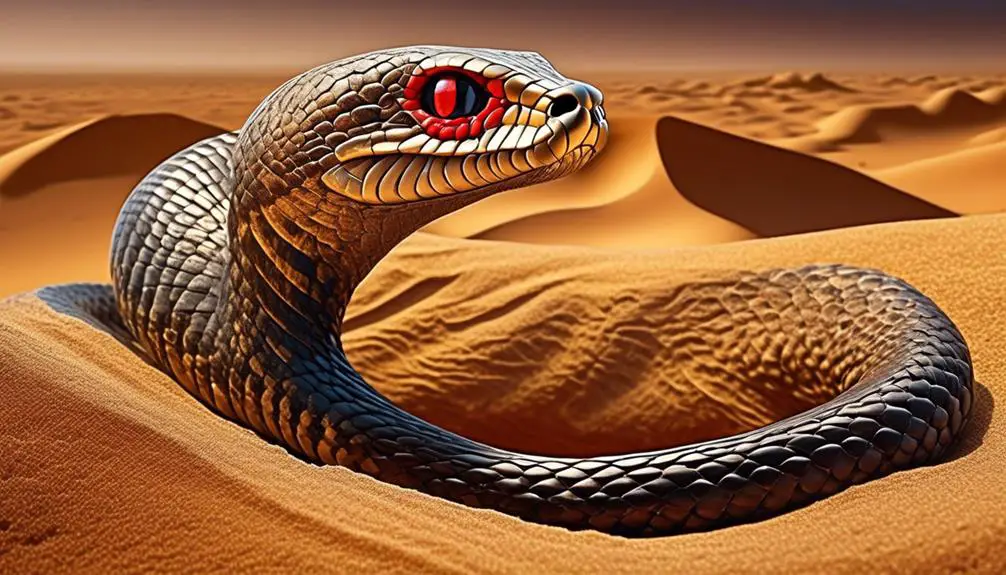
Known for its size, venomous potency, and distinctive appearance, the Egyptian Cobra is one of the most formidable snakes in Africa. With an average length ranging from 1.5m (5ft) to 2m (6.5ft), and some reaching up to 2.5m (8ft), this snake commands attention and respect. Its dark coloration, cobra-shaped head, and iconic hood set it apart from other species in the region. The Egyptian Cobra, also known as the Asp Snake, is the most widespread cobra in Africa, found in northern and western regions as well as the Congo. It prefers habitats such as savannahs, grasslands, agricultural areas, and areas near water.
To provide a comprehensive overview of the Egyptian Cobra, the table below summarizes key information about this species:
| Egyptian Cobra | |
|---|---|
| Average Length | 1.5m (5ft) to 2m (6.5ft), up to 2.5m (8ft) |
| Venom Potency | Highly venomous species |
| Appearance | Dark color, cobra-shaped head and hood |
| Distribution | Northern & western Africa, Congo |
| Preferred | Savannahs, grasslands, |
| Habitat | agricultural areas, areas near water |
The Egyptian Cobra’s venom is potent and can cause severe symptoms, including paralysis and respiratory distress. It possesses neurotoxins that affect the nervous system, leading to muscle weakness and potential respiratory failure. If bitten by an Egyptian Cobra, immediate medical attention is crucial to prevent serious complications.
Western Green Mamba
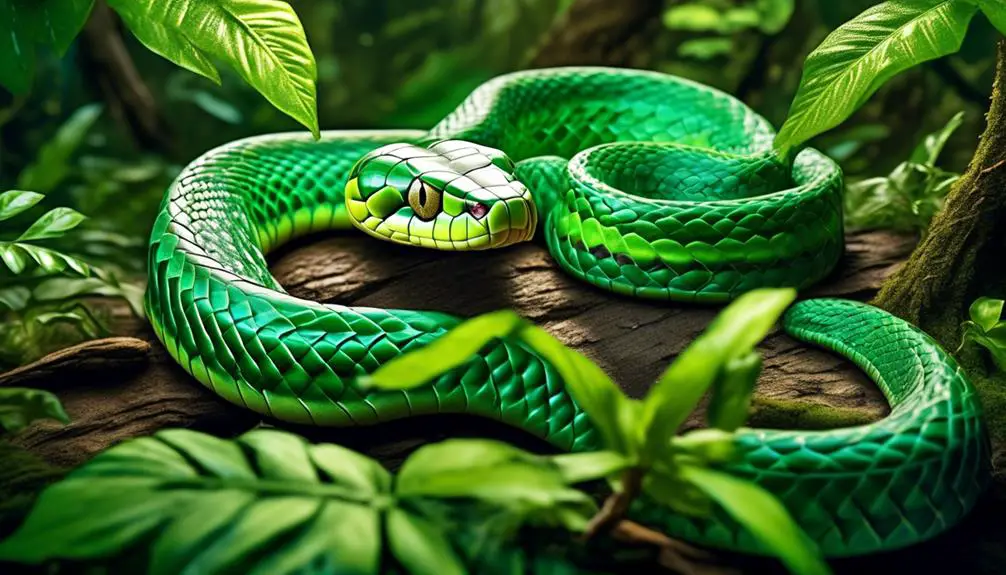
The Western Green Mamba, a highly venomous species known for its aggressive and unpredictable nature, emerges as the next snake of focus following the Egyptian Cobra.
This species is considered the most venomous and dangerous among the Green Mambas. Similar to the Black Mamba, its venom contains both neurotoxins and cardiotoxins, making it a formidable threat.
The Western Green Mamba is mainly found in coastal regions with thick woodland or rainforest in western Africa. Its ability to camouflage well with the tree canopy allows it to blend seamlessly into its surroundings, making it difficult to detect. However, it’s important to note that this snake can also enter thatched roofs of houses, posing a potential danger to humans.
To avoid encounters with the Western Green Mamba, it’s crucial to exercise caution when in these regions and take preventative measures to ensure personal safety.
Cape Cobra
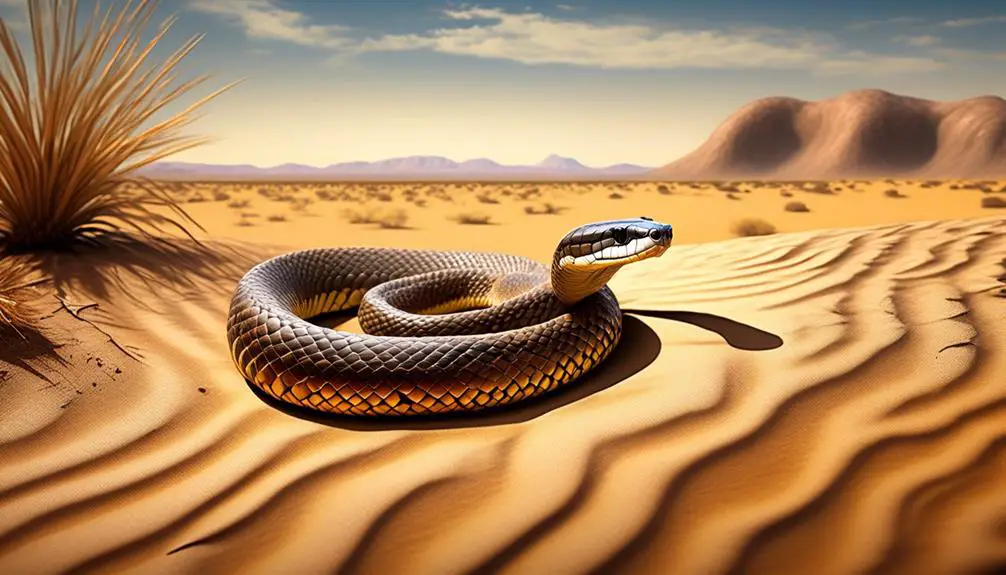
With its highly toxic venom and nervous disposition, the Cape Cobra ranks as one of the most venomous and dangerous snakes in South Africa. This snake, scientifically known as Naja nivea, is commonly found near human habitations, leading to frequent encounters. It becomes nervous around predators, increasing the likelihood of bites. When threatened, the Cape Cobra will rear back and expand its hood as a warning, but it may leave without striking if not provoked. However, if it does strike, its venom is highly toxic and attacks the nervous system, respiratory system, and heart.
To give you a clearer picture, here is a table highlighting key characteristics of the Cape Cobra:
| Cape Cobra | |
|---|---|
| Scientific Name | Naja nivea |
| Average Length | 1.2 – 1.4 meters |
| Color | Light to dark tan |
| Venom Type | Neurotoxic |
| Venom Effects | Nervous system, respiratory system, and heart |
It is important to exercise caution and avoid disturbing or provoking the Cape Cobra. If bitten, immediate medical attention should be sought to receive appropriate treatment. Remember, prevention and awareness are key in staying safe from these venomous creatures.
Additional Facts
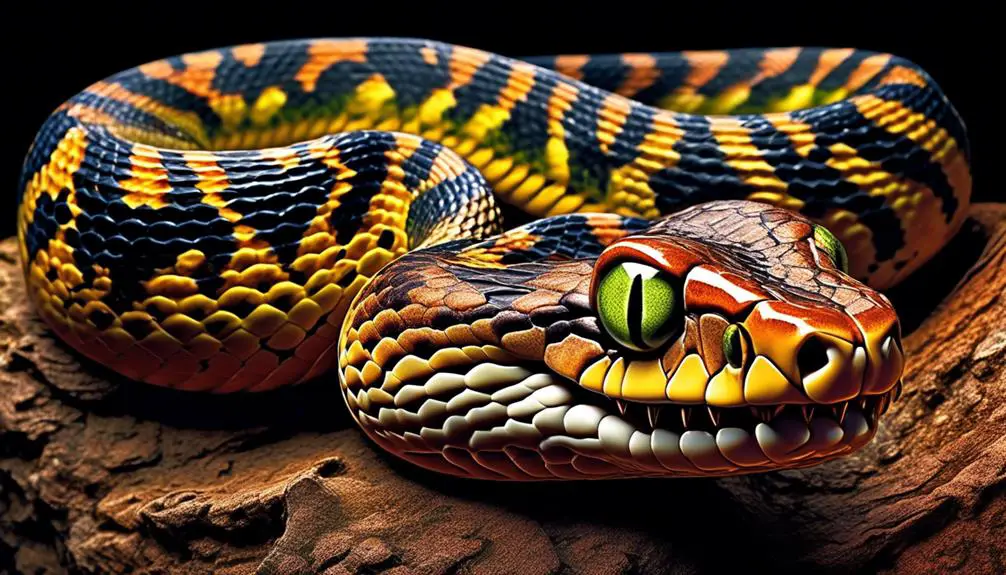
Africa isn’t only home to some of the most venomous snakes in the world, but it’s also a continent that boasts a staggering diversity of over 500 snake species, with approximately 137 of them being venomous or dangerous in some way.
The African Rock Python, for example, holds the title of the largest snake found in Africa, reaching up to 6 meters (20 feet) in length. This massive serpent is known for its ability to constrict its prey to death before devouring it whole.
On the other hand, the Puff Adder, responsible for the most human deaths in Africa, is often found near footpaths and hiking trails, making encounters with humans more likely.
It’s important to note that the venom of the Black Mamba is highly toxic and untreated bites are almost always fatal. With its speed, reaching up to 12 mph, and venom that takes effect in as little as 10 minutes, encountering a Black Mamba is a dangerous situation that should be avoided at all costs.
Africa’s snake population isn’t only diverse, but it also poses significant risks, making it essential to be knowledgeable and cautious when exploring its wild landscapes.
African Rock Python
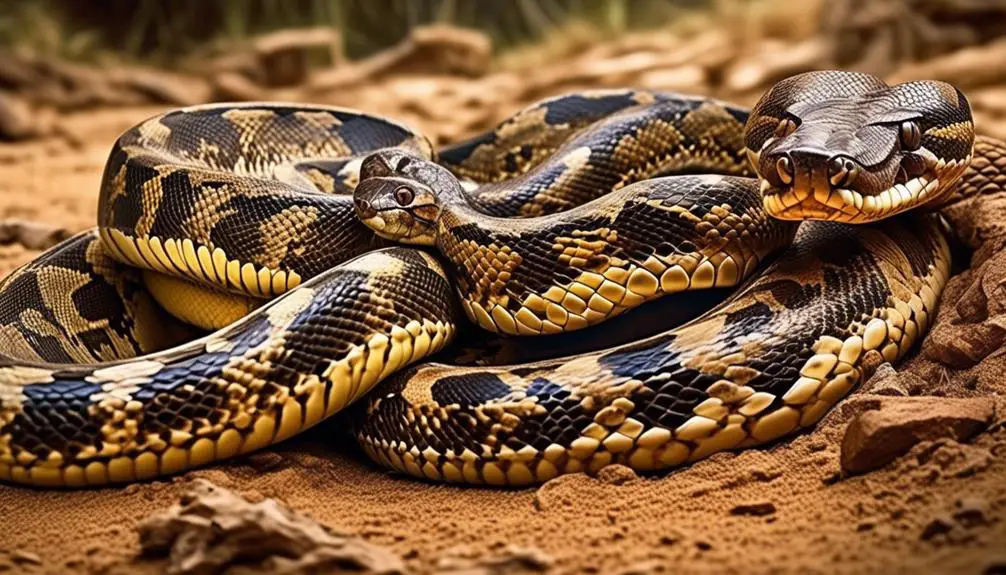
Reaching lengths of up to 6 meters (20 feet), the African Rock Python is a formidable serpent known for its ability to constrict and devour prey. This species is one of the largest snakes found in Africa and is highly adaptable, able to survive in a variety of habitats including forests, grasslands, and marshes. The African Rock Python has a distinct appearance, with a pattern of dark brown or black patches on a lighter background. Its scales are smooth and glossy, providing it with excellent camouflage.
The African Rock Python is a non-venomous snake and relies on its powerful muscles to suffocate its prey. It hunts a wide range of animals, including antelopes, monkeys, and even crocodiles. After capturing its prey, the python will constrict it until it can no longer breathe, then swallow it whole. This ability to consume large meals allows the African Rock Python to survive for long periods without feeding.
Despite its impressive size and strength, the African Rock Python is generally docile and avoids human contact. However, if threatened or provoked, it can become aggressive and may bite in self-defense. Encounters with humans should be avoided, as the snake’s bite can cause serious injury or even death.
Here is a visual representation of the African Rock Python:
| African Rock Python | |
|---|---|
| Size | Up to 6 meters (20 feet) |
| Habitat | Forests, grasslands, marshes |
| Appearance | Dark brown or black patches on a lighter background, smooth and glossy scales |
| Diet | Antelopes, monkeys, crocodiles |
| Behavior | Generally docile, but can become aggressive if threatened |

Erzsebet Frey (Eli Frey) is an ecologist and online entrepreneur with a Master of Science in Ecology from the University of Belgrade. Originally from Serbia, she has lived in Sri Lanka since 2017. Eli has worked internationally in countries like Oman, Brazil, Germany, and Sri Lanka. In 2018, she expanded into SEO and blogging, completing courses from UC Davis and Edinburgh. Eli has founded multiple websites focused on biology, ecology, environmental science, sustainable and simple living, and outdoor activities. She enjoys creating nature and simple living videos on YouTube and participates in speleology, diving, and hiking.

